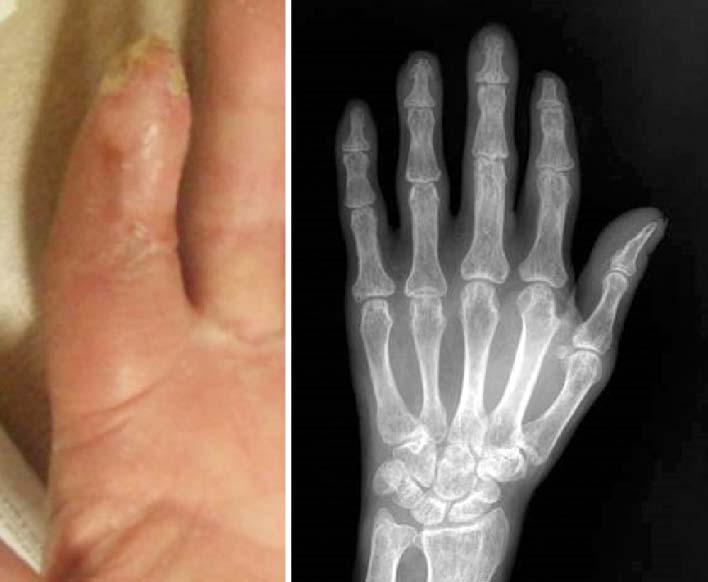Articles
- Page Path
- HOME > J Musculoskelet Trauma > Volume 28(4); 2015 > Article
-
Case Report
- Salvage Therapy from Traumatic Ischemic Finger Necrosis via Prostaglandin E1 Assisted Conservative Treatment: A Case Report
- Jae-Hyuk Shin, M.D., Ph.D., Ho-Guen Chang, M.D., Ph.D., Cheol-Jung Yang, M.D., Jungtae Ahn, M.D.
-
Journal of the Korean Fracture Society 2015;28(4):245-249.
DOI: https://doi.org/10.12671/jkfs.2015.28.4.245
Published online: October 19, 2015
Department of Orthopaedic Surgery, Hallym University Dongtan Sacred Heart Hospital, Hwaseong, Korea.
*Department of Orthopaedics and Traumatology, Cheju Halla General Hospital, Jeju, Korea.
- Address reprint requests to: Ho-Guen Chang, M.D., Ph.D. Department of Orthopaedic Surgery, Hallym University Dongtan Sacred Heart Hospital, 7 Keunjaebong-gil, Hwaseong 18450, Korea. Tel: 82-31-8086-2891, Fax: 82-31-8086-2438, jshin2100@gmail.com
• Received: July 8, 2015 • Revised: August 24, 2015 • Accepted: August 24, 2015
Copyright © 2015 The Korean Fracture Society. All rights reserved.
This is an Open Access article distributed under the terms of the Creative Commons Attribution Non-Commercial License (http://creativecommons.org/licenses/by-nc/4.0) which permits unrestricted non-commercial use, distribution, and reproduction in any medium, provided the original work is properly cited.
- 391 Views
- 2 Download
Abstract
- Prostaglandin E1 (PGE-1) is a potent vasodilator, which also inhibits platelet aggregation, affects the blood flow viscosity, and fibrinolysis. The compound also excerts anti-inflammatory effects by inhibiting the monocyte and neutrophil function. PGE-1 has been widely administered following microvascular flap surgery, along with perioperative antithrombotic agents such as low molecular weight heparin or aspirin, showing excellent results. We report a case showing successful salvage recovery from post-traumatic ischemic necrosis of the finger via PGE-1 assisted conservative treatment.
- 1. Brent B. Replantation of amputated distal phalangeal parts of fingers without vascular anastomoses, using subcutaneous pockets. Plast Reconstr Surg, 1979;63:1-8.Article
- 2. Lee JY, Teoh LC, Seah VW. Extending the reach of the heterodigital arterialized flap by cross-finger transfer. Plast Reconstr Surg, 2006;117:2320-2328.Article
- 3. Rodríguez Vegas JM, Ruiz Alonso ME, Terán Saavedra PP. PGE-1 in replantation and free tissue transfer: early preliminary experience. Microsurgery, 2007;27:395-397.Article
- 4. Matsudaira K, Seichi A, Kunogi J, et al. The efficacy of prostaglandin E1 derivative in patients with lumbar spinal stenosis. Spine (Phila Pa 1976), 2009;34:115-120.Article
- 5. Levy JM, Joseph RB, Bodell LS, Nykamp PW, Hessel SJ. Prostaglandin E1 in hand angiography. AJR Am J Roentgenol, 1983;141:1043-1046.Article
- 6. Weiner R, Kaley G. Influence of prostaglandin E1 on the terminal vascular bed. Am J Physiol, 1969;217:563-566.Article
- 7. Rowlands TE, Gough MJ, Homer-Vanniasinkam S. Do prostaglandins have a salutary role in skeletal muscle ischaemia-reperfusion injury? Eur J Vasc Endovasc Surg, 1999;18:439-444.Article
- 8. Campion T, Lynch TG, Kerr JC, Hobson RW 2nd. Effects of prostacyclin injections and infusions on canine femoral hemodynamics. J Vasc Surg, 1986;3:540-544.Article
- 9. Iversen VV, Reed RK. PGE1 induced transcapillary transport of 51Cr-EDTA in rat skin measured by microdialysis. Acta Physiol Scand, 2002;176:269-274.ArticlePDF
- 10. Cavadas PC. Supramicrosurgical ear replantation: case report. J Reconstr Microsurg, 2002;18:393-395.Article
REFERENCES
Fig. 1

Initial crushing injury to the index finger. Circulation and sensation were negative at the distal phalangeal part of the injured finger. (A, B) Preoperative image. (C) Intraoperative image.

Fig. 2

At postoperative two weeks, the index finger showed gangrenous necrosis distally from the proximal interphalangeal joint level. During the follow-up period with prostaglandin E1 assisted conservative treatment at postoperative 7 weeks, at 8 weeks, and at 11 weeks, the wound healing proceeded, and the necrotic tissue decreased. At postoperative 14 weeks, the Salvage-therapy reconstruction was complete. (A) 2 weeks, (B) 7 weeks, (C) 8 weeks, (D) 11 weeks, and (E) 14 weeks, postoperatively.

Figure & Data
REFERENCES
Citations
Citations to this article as recorded by 

Salvage Therapy from Traumatic Ischemic Finger Necrosis via Prostaglandin E1 Assisted Conservative Treatment: A Case Report



Fig. 1
Initial crushing injury to the index finger. Circulation and sensation were negative at the distal phalangeal part of the injured finger. (A, B) Preoperative image. (C) Intraoperative image.
Fig. 2
At postoperative two weeks, the index finger showed gangrenous necrosis distally from the proximal interphalangeal joint level. During the follow-up period with prostaglandin E1 assisted conservative treatment at postoperative 7 weeks, at 8 weeks, and at 11 weeks, the wound healing proceeded, and the necrotic tissue decreased. At postoperative 14 weeks, the Salvage-therapy reconstruction was complete. (A) 2 weeks, (B) 7 weeks, (C) 8 weeks, (D) 11 weeks, and (E) 14 weeks, postoperatively.
Fig. 3
At postoperative 4 months, the finger was Salvage-reconstructed. Pulp hypotrophy was noted but the partially maintained active range of motion enabled active cupholding (see the main text).
Fig. 1
Fig. 2
Fig. 3
Salvage Therapy from Traumatic Ischemic Finger Necrosis via Prostaglandin E1 Assisted Conservative Treatment: A Case Report

 E-submission
E-submission KOTA
KOTA

 Cite
Cite

